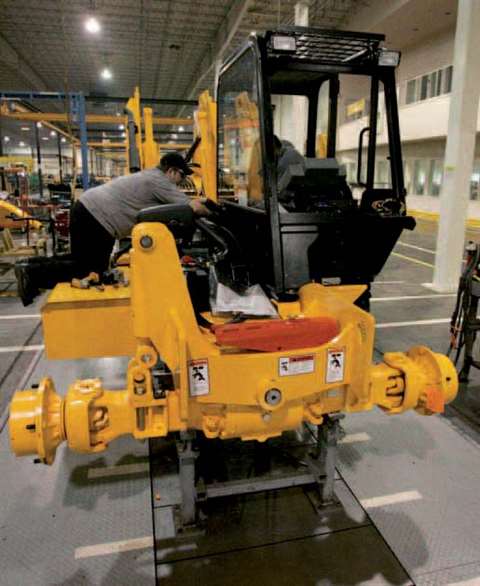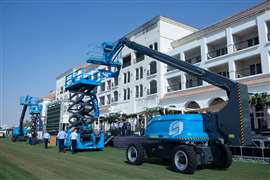Handlers Across: JCB start US manufacture of its telehandlers
15 April 2008

JCB's telehandler business in North America is getting a boost as the company starts to manufacture handlers at its Pooler, GA facility. John Wyatt reports.
As Helmut Peters ends his tenure with JCB North America, he leaves the company and his replacement, new president Graeme Macdonald, on quite a promising note. As 2007 dawned, JCB implemented several changes that reflect solid growth and a strong business plan.
The company's North and South American business units merged to become JCB Inc. – the Americas; CEO John Patterson is now stationed in the states; and Loadall telehandlers are being manufactured in the Pooler, GA facility for the first time.
As of October 2006, the Loadall models 506C, 506C HL and 508C are being made in the USA. To meet stateside demand, the company invested $1 million in telehandler production at its Pooler plant. The North American market also takes some of JCB's European–style, side–engine, low boom pivot models, although production of these will remain in the UK.
“Increased volumes and presence in both the US and Canada makes this a natural evolution for JCB – making the US the first overseas facility for JCB Loadalls,” says Richard FoxxMarrs, director and general manager of the JCB Loadall division.
JCB general manager of product marketing, George Chaney, tells ALH that because the North American market is “off the charts,” it makes sense to produce these machines across the Atlantic. This decision suggests that the company views the marketplace in a very healthy state. Approximately 1,500 JCB telehandlers are sold in North America annually, of which around two–thirds are the US–style high–boom models favored by rental companies.
“The main reason to manufacture the lift and place machines in Savannah is the fact that they are truly North American products and I' m under the belief that 95 percent of those products that we manufacture would be sold in North America anyways,” says Chaney.
North American customers will benefit from the move, as Chaney explains. “Having the production here should improve lead times on product because we don't have the shipping and transport delays. There's normally a three–week lag time (from across seas). Sometimes it takes four weeks for a complete turnaround.”
506C, 506C HL and 508C
The smallest of the three models now being made at Pooler is the 506C, with a 6,000 pound lift capacity at a maximum lift height of 36 feet. At its full reach of 22.5 feet, the machine will lift 2,000 pounds. The 506C HL offers a high lift performance 6,000 pounds at a lift height of 42 feet and 1,500 pounds at a maximum forward reach of 27.5 feet, and the 8,000 pound lift capacity 508C has a maximum lift height of 41 feet 6 inches.
“All three of those are lift–and–place machines,” says Chaney. “We differentiate that from our regular design in that the machines have a high boom…These machines have an engine–mounted rear machine transmission mid shift and the tool carrier machines’ engines are on the side.” All the models use JCB Dieselmax engines.
Chaney calls the Loadall units “a smooth ride machine…When you' re carrying a load over rough terrain, you' ll get a shock effect as that load is transmitted from the hydraulic system through the machine,” he says. “We put a nitrogen precharge accumulator in the lift circuit. As you transport that load on rough terrain, that shock loading goes inside the nitrogen–charged accumulator and absorbs that shock loading so the machine travels smoothly, increasing productivity tremendously.”
When the Loadall was first introduced in 1977, it appealed to the agricultural market as a “tractor–type product,” according to Chaney. But as the product evolved it became more construction oriented, with power–shift transmission, high–pivot axles, submersed disc brakes and other developments that made it appeal to the material handling sector.
The present–day Loadall doesn't look anything like the first–generation models. However, testament to the product's build, the first Loadall 520 to come off the assembly line is still running, located in Ayrshire, Scotland. It now has some distant cousins in Pooler.






